Case Study
Training Program for Human Resources Development in the Mining Sector (Kizuna Program)
Fostering Kizuna (Bonds of Friendship) between Japan and the World through Human Resources Development
Japan, which until recently had many operating mines, has vast experience in overcoming mining pollution with technology. The Kizuna Program, launched in March 2014, takes advantage of this technology and experience for the development of mining in developing countries, thereby contributing to stable supply of mineral resources.
Transferring Japan's Experience in Mineral Resources Management to Developing Countries
For developing countries endowed with such resources, mineral resource development provides a more powerful engine for growth that produces outcomes sooner than the development of other industries does.
There are concerns, however, that if a developing country with inadequate administration systems for mining resources management hastens to develop such resources, its economy may become so dependent on mining that the country will face a number of negative outcomes, including an impediment to the development of other industries, a growing gap between rich and poor, and local mining pollution. Long-term national development through mining calls for broad-based capacity for mineral resources management that covers everything from regulatory framework development and resources exploration and development to mine safety and mining environmental management — especially with regard to mining pollution — and mine closure.
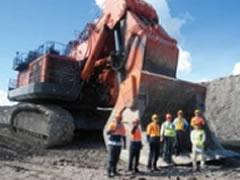
A coal mine in Mozambique's northwestern Tete province
The Kizuna Program is designed for participants to develop their capacity in such a wide range of aspects, it offers an array of subprograms. They include a program to obtain a master's or doctor's degree from a Japanese university; an internship program; a JICA short-term program, which combines lectures on mining policy and management with inspection tours to relevant facilities; and an overseas field research program. Support for mining development in developing countries will contribute to stable and sustainable supply of mineral resources to other parts of the world, including Japan. It also is expected to bolster the revitalization of the mining industry and the sustainable growth of the manufacturing industry in Japan.
Case Study
Pacific Region: Hybrid Islands Initiative
Assisting Small Island States in Improving Energy with Japan's Knowledge and Technology
Pacific island countries are faced with two energy challenges: the high risk of fluctuations in the cost of fuel for power generation, and low energy self-sufficiency. To help them address these challenges, JICA is supporting the development of a hybrid grid system that involves making diesel power generation more efficient and introducing renewable energy on an optimal scale.
Japan's Technology and Cooperation with the Stakeholders Essential
Many small island states are not endowed with energy resources and are isolated geographically. These countries are heavily dependent on imported diesel fuel for their power supply, which constitutes the foundation for people's lives. High power costs and the risk of fluctuations in oil prices pose a major challenge.
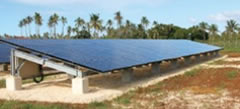
A solar power generation facility in Tonga
Under these circumstances, small island states have been building their expectations for renewable energy in recent years. Renewable energy is not a panacea, however. While providing an opportunity to increase energy self-sufficiency and reduce fuel costs, renewable energy has its own weaknesses. For one, power output fluctuates widely according to the weather. Also, excessive dependency on renewable energy may reduce the quality of electric power and destabilize the supply.
The question is how to achieve the two objectives of reducing dependency on diesel power generation and utilizing renewable energy at the same time. To answer this question, JICA launched the Hybrid Islands Initiative, designed to improve energy security in small island states, to coincide with the Pacific Islands Leaders Meeting held in May 2015. To put the initiative into practice, it is essential to work with Japanese stakeholders. JICA has been drawing on the experience of Okinawa, the southernmost island prefecture in Japan, to train the people responsible for power supply in small island states. More recently, progress has been made both in the introduction of power system stabilizers that use Japan's latest technology and in the partnership with Okinawa-based companies. JICA will continue to seek more and better assistance for improving energy security in small island states based on Japan's knowledge and technology.
Case Study
Kenya: Olkaria I Unit 4 and 5 Geothermal Power Project
Contributing to a Stable Power Supply that Meets the Growing Power Demand
JICA is providing cooperation for construction of a clean-energy geothermal power plant to increase and stabilize power output in Kenya to meet growing power demand brought on by economic growth. In January 2015, a 140,000 kW geothermal power plant for which JICA provided ODA Loans began operating.
Geothermal Power Generation Attracting Attention as a Stable Clean Energy
Power demand in Kenya is increasing year by year on the back of strong economic growth, and is forecast to continue increasing at 14.5% per annum until 2020. With extensive confirmed geothermal resources beneath the Great Rift Valley, [1] Kenya has been carrying out geothermal development since the 1970s.
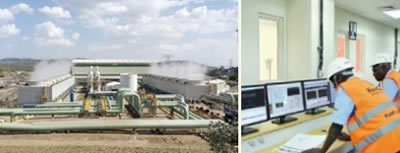
Olkaria I Geothermal Power Plant Units 4 and 5 (left). Kenya Electricity Generating Company employees monitoring the operation of the power plant (right).
Geothermal power generation generates power using steam from deep underground, and is attracting attention as a stable power generation system unaffected by climate. Thus, geothermal power generation is an environmentally friendly form of energy with low CO2 emissions, so in this regard as well the further development of geothermal power generation in Kenya is encouraged.
Contributing to Stable Power Supply in Eastern Africa
In March 2010, JICA signed an ODA Loan agreement with the Kenyan government to construct a power plant in the Olkaria geothermal region. [2] Japanese companies received the orders for construction under this project. Japanese-made turbines were delivered, and the geothermal power plant began operating in January 2015.
The Kenyan government plans to cover about 30% of the total capacity of its power generation facilities with geothermal power by 2030. To accelerate Kenya's sustained economic development, JICA will continue to provide cooperation for the development of Kenya's geothermal power generation that can meet its expected growing power demand.
Notes
[1] The Great Rift Valley is a vast valley that cuts through the African continent from north to south, and is one of the plate boundaries. High geothermal temperatures are observed around the valley.
[2] A volcanic zone located 75 kilometers northwest of the Kenyan capital, Nairobi.
Case Study
Bolivia: Laguna Colorada Geothermal Power Plant Construction Project (Phase 1 of First Stage)
The First Japanese ODA Loan in 22 Years for Construction of the First Geothermal Power Plant in South America
Aiming at responding to future electricity demand and stabilize Bolivia's domestic power supply through geothermal power plant construction, JICA signed an ODA Loan agreement with the Government of Bolivia in July 2014.
Electricity Demand Growing Each Year
Potosi, a department located in the southern part of Bolivia, is one of the world's largest producers of zinc, lead, and silver. Due to the active mining development, electricity demand is growing each year. However, since the southwest area of the Potosi department is situated at high altitude of 3,600 meters and above, not only is it difficult to implement large-scale thermal power generation, but hydroelectric power generation is also not suitable for the area. This situation has resulted in an absence of power-generating facilities that satisfy the electricity demand. Although power is currently supplied to the area via long-distance power transmission, this system, accompanied by significant electricity loss, causes power outages when a transmission line accident occurs.
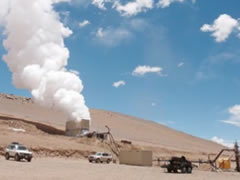
Conducting a well testing
Mineral resources and related products are Bolivia's core export goods, and a slowdown in mine development due to an unstable power supply can inflict a serious impact on the country's economy. Thus, it is important to ensure a stable power supply. In this context, the Bolivian government is promoting diversification of power sources, and the introduction of renewable energy is regarded as one of the key pillars for that effort.
In such circumstances, it has been confirmed that the southwest area of Potosi department has a potential for geothermal resources development, and the Bolivian government drew up the Laguna Colorada Geothermal Power Plant Construction Project to utilize these resources. In this project, aimed at establishing a 100-MW-scale power-generating facility, it was planned that a 50-MW power plant be constructed as the first stage. The support for this project was officially endorsed in the Japan–Bolivia Joint Statement signed in December 2010 by then Japanese Prime Minister Naoto Kan and Bolivian President Evo Morales, who was visiting Japan at the time.
In response to this move, JICA provided an ODA Loan for the Phase 1 of the first stage of this project. JICA will facilitate the development of renewable energy and help mitigate climate change under this project by easing the urgent electricity demand and stabilizing the power supply in Bolivia.
The World's First Geothermal Development at High Altitude of More Than 5,000 Meters
Construction of the Laguna Colorada Geothermal Power Plant is the world's first geothermal development at high altitude of more than 5,000 meters. The atmospheric pressure of the area is about half that of sea level. Therefore, customization is required for some equipment, and it is also essential to ensure the safety of workers. Prior to providing an ODA Loan, JICA has conducted technical cooperation since 2010 with regard to well testing, enlightenment activities, and capacity development for geothermal power generation, as well as smooth implementation of the project. Other technical cooperation, such as institutional reinforcement, will be also provided.
Case Study
Oman: Project for Energy Conservation Master Plan in the Power Sector
Cooperation for Electricity Suppliers Is Followed by Support for Energy Conservation Measures among Users
Demand for electricity in Oman is expected to increase at an annual rate of more than 10% as the country's population and economy expand.
JICA extended cooperation from 1997 to 1998 for rationalizing systems used by the country's electricity suppliers. Starting in 2012, JICA is providing assistance in creating a master plan for the promotion of energy conservation by users of electricity.
Thermal power plants fueled by gas produced in Oman accounts for more than 90% of the country's electricity. Since electricity rates are low, people have little interest in the conservation of power. However, electricity consumption has been rising rapidly in recent years because of population and economic growth, with demand increasing in Muscat, the capital, and other areas in Oman. During the summer, there are even rolling blackouts at times. As a result, energy conservation has become an important issue in Oman.
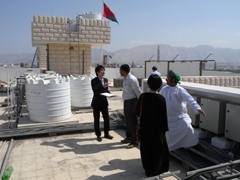
A survey to determine electricity use in Oman
From 1997 to 1998, JICA performed a rationalized survey on the electricity supply and demand management system. In this study, JICA provided advise about a system to mange power in response to changes in the demand for electricity. However, there were no initiatives for the users of electricity.
The Oman Public Authority for Electricity & Water requested Japan's support in improving the management between the supply and demand of electricity by promoting energy conservation among users. In response, JICA started the Project for Energy Conservation Master Plan in the Power Sector in February 2012.
The purpose of the project is to study a Master Plan for energy conservation in Oman up to 2020.This plan is based on on-site surveys and energy diagnosis to determine electricity use at factories and other business sites, buildings, stores and homes. How to utilize Japan's experience and technologies in energy conservation will be determined. The recommendation may include 1) the creation of standards for energy-efficient products as well as promoting their use, and 2) activities to raise awareness of the need to conserve energy.




scroll